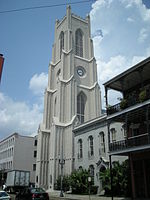Hale Boggs Federal Complex
1962 establishments in LouisianaLouisiana building and structure stubsModernist architecture in LouisianaOffice buildings completed in 1976Office buildings in New Orleans

The Hale Boggs Federal Complex, also known as the Hale Boggs Federal Building-Courthouse, is a historic building in New Orleans, Louisiana. It was built in 1976. It was designed in the Modernist architectural style. It was named in honor of Democratic Congressman Hale Boggs who disappeared over Alaska in 1972.
Excerpt from the Wikipedia article Hale Boggs Federal Complex (License: CC BY-SA 3.0, Authors, Images).Hale Boggs Federal Complex
Poydras Street, New Orleans Storyville
Geographical coordinates (GPS) Address Nearby Places Show on map
Geographical coordinates (GPS)
| Latitude | Longitude |
|---|---|
| N 29.948611111111 ° | E -90.069166666667 ° |
Address
Hale Boggs Federal Building
Poydras Street 500
70130 New Orleans, Storyville
Louisiana, United States
Open on Google Maps









